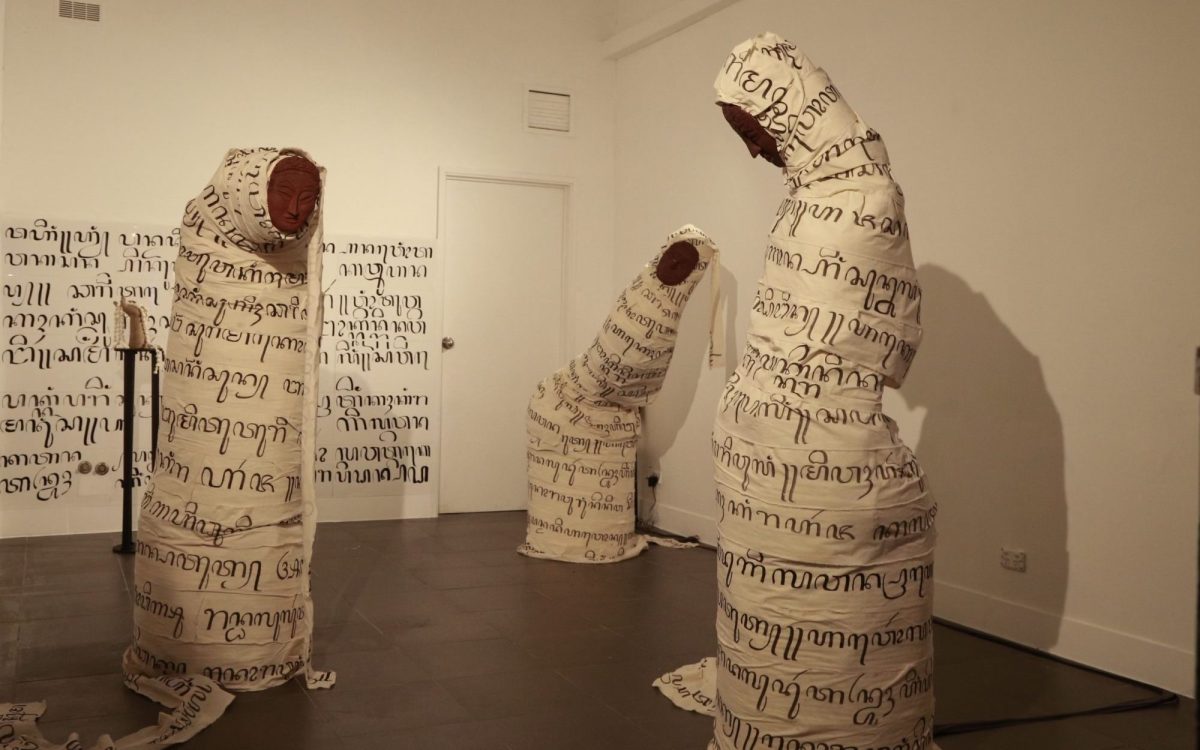The exhibition Anugerah: (Bestowed) by Addin Sugarda presents a compelling narrative that delves into the intricate interplay between cultural identity and modernity. The exhibition stands as testament to Sugarda’s meditative and authentic exploration of her roots, while also offering a broader commentary on the universal longing for cultural intimacy.
At the heart of Anugerah is the classical Javanese poem ‘Tembang Macapat’, which provides a philosophical foundation for Sugarda’s work. This traditional literary form becomes a vessel through which the artist reimagines cultural heirlooms and rituals. The ‘Tembang Macapat’ illustrates the dichotomy between idealistic philosophy and practical reality, showing how experiences and social conditioning distance one from cultural values. The poem contrasts idealistic views on fate with societal expectations, highlighting the tension between maintaining cultural values and facing social judgement, resonating with the artist’s cultural estrangement. By situating ‘Tembang Macapat’ at the core of her exhibition, Sugarda uses it as a lens to scrutinise and reinterpret the past.
The exhibition is characterised by its creation of fictitious heirlooms and rituals. These artefacts are deeply rooted in authentic cultural practices and imbued with the trauma and shame of historical dislocation. Sugarda’s work can be viewed as an act of liberation from the rigid confines of cultural heritage – a profound attempt to restore wholeness in her estrangement from her ancestral traditions.
Each piece in Anugerah is meticulously crafted, drawing inspiration from genuine cultural artefacts and processions. These creations are not mere reproductions; they are reshaped by Sugarda’s personal experiences of the material. An example are the clay masks, traditionally crafted from wood, which she began creating after a personal encounter with a family friend and ceramicist, during her visits to Indonesia. This encounter sparked her deepening appreciation for the medium, leading to the meticulously crafted clay masks adorned with traditional motifs as a homage to her growing wisdom of Javanese culture, on display at HAIR ARI. This creative process can be seen as an act of healing and reclamation, where the artist confronts and transforms the growing pains of cultural dislocation into a new form of expression.
Sugarda’s work also explores the trauma of enforced filial piety. By creating cathartic ritualised performances, Sugarda delves into how shame, guilt and self-preservation are acquired through lineage and cultural conditioning. The closing performance on 30 May will showcase how she releases these tensions in her body from her traumatic upbringing through the somatic making of art and ritualised performances.
The exhibition invites viewers to question the boundaries of cultural authenticity and the ways in which cultural narratives are preserved and transformed. Sugarda’s work challenges the notion of static cultural heritage, suggesting instead that culture is a living, evolving entity that must adapt and respond to the experiences of its people.
Sugarda’s meditative approach to art-making is evident in the careful attention to detail, the profound emotional resonance of each piece and the voice in her performance. By reimagining cultural heirlooms and rituals, she creates a space for reflection and introspection, prompting viewers to consider their own relationship with their heritage and how it shapes their identity.
Through her fictitious, yet deeply authentic creations, Sugarda’s work challenges the viewer to confront and find solace in the complexities of our own cultural narratives.
Anugerah: (Bestowed) is on view from 23 May to 2 June at HAIR ARI.
The closing event on Thursday, 30 May from 6-8pm, will feature the artist’s live performance with other performance acts by Melbourne-based multi-instrumentalist Will Vov and Xhabarabot, the musical AI creation of vocalist and composer Rully Shabara, in conjunction with SALON #03: Sanggar.





